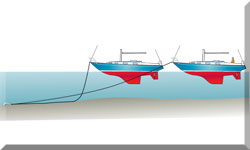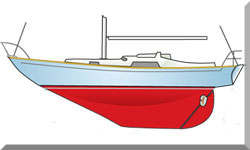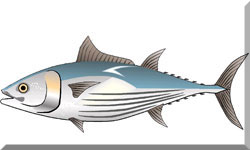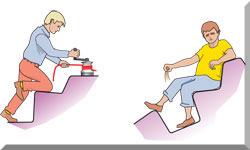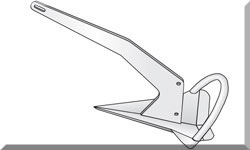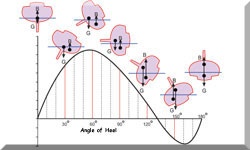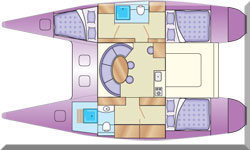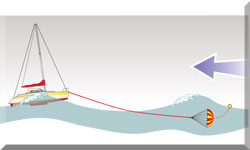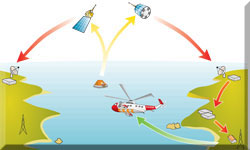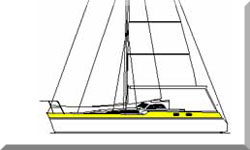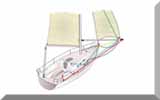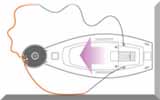- Home
- Cruising Sailboats
- Water Ballast Systems
Are Water Ballast Systems Worth the Bother?
In a Nutshell...
For a modern, light-to-moderate displacement, wide beamed cruising yacht, the answer is a resounding yes—Water Ballast Systems are absolutely worth the complexity. They aren't meant to replace your fixed ballast, but rather to top it up, significantly boosting the righting moment, cutting down on heel, and substantially increasing crew comfort by simply dampening that awful pitch and roll on long offshore passages. They actually hit a sweet spot between fixed keels and the crazy, expensive dynamic systems. The main trade-off is the space the tanks eat up and the slight faff of switching the ballast on every tack, which is why we save them for long hauls.
Table of Contents
- The Traditionalist's View versus Reality
- The Practicalities of Water Ballast Aboard my Sailboat 'Alacazam'
- The Physics & Performance Gains
- Crucial Design & Engineering Considerations
- Water Ballast Versus Dynamic Systems: Canting & Swing Keels
- From Grand Prix Racing to Offshore Cruising: The Evolution of Water Ballast
- Is the Investment Worth It? The True Value of Performance & Comfort
- What Could Go Wrong? Mitigating Risks & Failure Modes
- Summing Up
- Frequently Asked Questions
The Traditionalist's View versus Reality
The concept of a water ballast system in a cruising yacht probably makes many traditionalists wince. They’ll tell you that a boat's stability ought to be inherent in her form and fixed ballast, and they wouldn't be wrong in principle. But for a modern cruiser, especially one designed for quick passage-making—which is, after all, an essential feature of all good cruising sailboats—water ballast offers a clever, performance-enhancing trick up your sleeve.
Provided your boat isn’t dependent on it for basic stability—a crucial distinction, that—it can be incredibly beneficial, particularly when you’re hard on the wind in a proper seaway. It's really about adjustable displacement, allowing you to get the power and stability of a much heavier boat exactly when you need it, without lugging all that dead weight everywhere else. It's a system that just recognises the practicalities of modern boat design and sailing requirements.
The Practicalities of Water Ballast Aboard my Sailboat 'Alacazam'
When we built Alacazam, the water ballast system was baked right into the original design philosophy. The goal wasn't to save money on lead but to simply boost the permanent ballast in the keel bulb, giving us that extra weight to windward precisely when it was required.
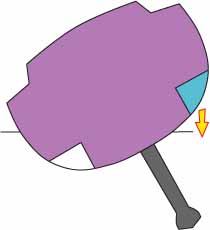 The concept of water ballast
The concept of water ballastThe system is surprisingly simple in concept. We fitted two tanks on each side, situated right out at the extremities of the waterline beam, well below the point of maximum beam. Each tank can be independently filled and drained via a pair of 12V electric pumps. Concentrating that weight right out there—at the widest possible point—is what delivers the substantial performance and comfort gains we rely on.
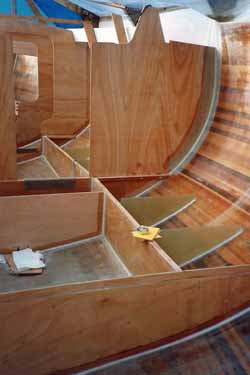 The starboard-side ballast tanks during the construction of Alacazam. Note the baffle plates to reduce surge.
The starboard-side ballast tanks during the construction of Alacazam. Note the baffle plates to reduce surge.Freshwater Versus Seawater: The Weighting Game
Initially, I was reluctant to give up the potential for increased freshwater capacity. The experienced cruising sailor in me saw a chance to carry more drinking water, so the ballast tanks were first plumbed to top up our standard tanks. That quickly proved impractical, though.
After lugging over 1,000 lbs of water all the way across the Atlantic without using it for ballast or consumption—just pure dead weight—I converted it to a seawater system. Now, I can just dump it and replace it as needed, thinking of it correctly as adjustable displacement. It’s far more flexible and sensible for genuine ocean sailing.
The Tacking Conundrum
On a long offshore tack, the system's a dream. Tacking involves opening a couple of simple valves and flicking on the appropriate transfer pump. The boat is then tacked normally, and when the transfer is finished, the valves are closed and the pump's switched off.
Hard on the wind, with both windward tanks full, Alacazam sails about 6o flatter for the same sail area and wind strength than she otherwise would. That translates directly into increased boat speed and, more importantly, a much easier motion. Concentrating the outboard weight in the centre section of the boat noticeably improves the fore-and-aft stability. This, coupled with less heel, appreciably cuts down pitch and roll—the increased displacement just making the boat generally more comfortable for the crew.
But let's be honest about the mechanics: in a short-tacking situation, all that constant valve turning and pump switching involved in swapping the water from one side to the other requires a lot more rushing about than I’m used to. We simply reserve the water ballast system for long, committed offshore tacks. As the wind moves aft, the forward tank is drained, and when well off the wind, both tanks are drained entirely.
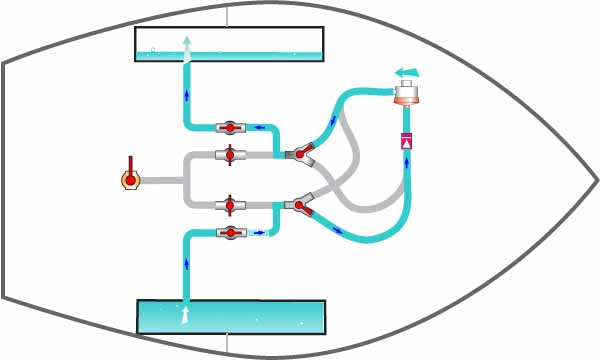 There's a fair amount of plumbing involved...
There's a fair amount of plumbing involved...The Physics & Performance Gains
The practical benefits of water ballast are rooted in simple hydrodynamics. The main goal is to boost the boat's righting moment by shifting weight as far outboard and as high up the heel curve as possible.
When the system is correctly engaged, you experience four primary improvements:
- The boat's Centre of Gravity (CG) is deliberately shifted outboard from the centreline
- As the boat heels, the righting moment increases significantly because the horizontal distance between the hull's centre of buoyancy and the water ballast's centre of gravity has been extended.
- The Roll Moment of Inertia is substantially increased in terms of both pitch and roll, which is the main reason for the improved comfort and motion on deck.
- Crucially, if you forget and get caught with the ballast on the wrong (leeward) tack, the increase in heel isn't dramatically affected; the permanent ballast in the keel still does the heavy lifting for primary stability.
Crucial Design & Engineering Considerations
Adding water ballast isn't a simple bolt-on job; it has to be integrated into the boat’s design from the outset. For a system to be effective, the total volume needs to be sufficient to make a genuine difference to the boat’s displacement and stability curve—this is typically 3−5% of the yacht’s total displacement.
The engineering must account for the high flow rates required to shift the water quickly. A slow transfer pump is useless in a sudden squall or during a necessary tack. Furthermore, the tank construction needs to be incredibly robust to handle the sloshing of several hundred litres of water, and the plumbing requires thoughtful anti-siphon loops and reliable through-hull fittings. When assessing if a particular design feature is right for your next vessel, it’s always worth taking a step back to consider how it fits into The Essential Features of All Good Cruising Sailboats.
The table below offers a simple comparison between the core stability types:
| Feature | Water Ballast | Fixed Keel Ballast |
|---|---|---|
| Weight Location | Adjustable, moved to windward extremity. | Permanent, fixed low in the keel or hull. |
| Primary Goal | Boost righting moment & damp motion for comfort & speed. | Provide fundamental, inherent stability and initial righting moment. |
| Flexibility | Highly flexible; can be jettisoned when not required. | Zero flexibility; permanent weight carried in all conditions. |
| Space & Complexity | Requires tanks, plumbing, pumps, and electrical systems. | Requires no additional internal space or operational complexity. |
Water Ballast Versus Dynamic Systems: Canting & Swing Keels
To truly appreciate where water ballast fits into modern yacht design, you’ve got to compare it to other dynamic stability solutions. The key differences boil down to complexity, cost, and primary function.
| System | Primary Function | Complexity & Cost | Failure Mode |
|---|---|---|---|
| Fixed Keel | Inherent, foundational stability & low CG. | Low; maintenance is structural only. | Grounding damage or fatigue failure. |
| Water Ballast | Performance enhancement, heel reduction & motion damping. | Moderate; requires pumps & plumbing. | Pump or valve failure; electrical reliance. |
| Canting Keel | Maximum righting moment for extreme speed. | High; hydraulic systems & complex structures. | Hydraulic failure; catastrophic structural risk. |
Water ballast is essentially a static weight transfer system—the weight is fixed once you're on a tack. A canting keel is dynamic; it actively shifts a massive lead bulb (often 30% of displacement) using powerful hydraulics. While a canting keel delivers superior performance, its catastrophic failure risk, huge cost, and maintenance demands make it impractical for cruising. Water ballast, however, gives you 80% of the comfort benefits at a tiny fraction of the structural and financial headache.
From Grand Prix Racing to Offshore Cruising: The Evolution of Water Ballast
It's helpful to remember that water ballast isn't a cruising innovation; it came straight out of the high-stakes world of Grand Prix racing. The technology was pioneered and perfected on yachts like the Open 60s and the Volvo Ocean Race (now The Ocean Race) boats. These race machines were designed to be incredibly light to maximise speed off the wind, but they desperately needed stability when beating into a heavy sea.
The racing systems are massive and complex, often mandatory, and rely on shifting huge volumes of water extremely fast. In contrast, the systems adapted for cruising yachts like Alacazam are much smaller, simpler, and designed for a completely different job.
Cruising systems are scaled down to:
- Enhance Comfort: The main benefit for us cruisers is reducing heel and damping the violent motion of pitching and rolling, making passages far more tolerable.
- Increase Performance Marginally: It grants you an extra knot or two of speed upwind without requiring an excessively deep or heavy keel.
This evolution just confirms the system's proven effectiveness and robustness under the worst ocean conditions, lending huge credibility to its use in a moderate cruising setting.
Is the Investment Worth It? The True Value of Performance & Comfort
For an experienced sailor, the true value of a water ballast system isn't found on the invoice; it’s measured in reduced fatigue and faster passage times.
Quantifiable Gains on Passage
- Reduced Crew Fatigue: 6∘ less heel doesn't sound like much, but it means bunks are flatter, the galley is functional, and working on deck is genuinely safer. Over a 20-day ocean passage, the reduction in physical and mental strain is enormous. I can tell you from experience, fatigue is the cruising sailor’s greatest safety risk.
- Time Savings: If the system provides a sustained half-knot advantage (which is a realistic goal upwind) on a 2,000-mile passage, that saves approximately 83 hours of sailing time. That's three and a half days less exposure to the ocean and three and a half days saved on perishable supplies.
The Hidden Cost: Power Consumption & Electrical Draw of Water Transfer
Since water transfer relies on 12V electric pumps, this system places a considerable, albeit short-lived, load on your ship’s power management system.
High-flow pumps, necessary to shift 500 litres in, say, 8 minutes, can draw between 20 and 40 Amps each. If your system runs two pumps simultaneously for this transfer time, you could be drawing 40–80 Amps.
While this draw is brief, if you’re short-tacking every hour during a day passage, the cumulative power drain is significant and you've got to account for it.
Practical Solutions:
- Dedicated Power Source: Make sure your house battery bank is sized appropriately.
- Engine/Generator Usage: On longer passages, we often run the main engine or a small diesel generator for a few minutes while transferring the ballast. This ensures the current draw is covered by high-output charging, preventing the unnecessary draining of the battery banks.
- Efficiency: Use the ballast system only when you genuinely need it—i.e., on those long, committed offshore tacks.
What Could Go Wrong? Mitigating Risks & Failure Modes
Any system that involves large through-hulls, moving fluids, and electrical power has potential failure points. Ignoring them would be irresponsible. As a seasoned ocean sailor, you must understand the risks involved and how to mitigate them.
The key risks include:
- Pump Failure: If the primary pump fails, you can't switch the ballast or empty it quickly. The fix is essential: redundant electric pumps or a simple, non-electrical secondary system is needed.
- Valve & Plumbing Failure: Corroded or failed valves could mean you can’t seal the tanks, potentially leading to slow leaks or unwanted ingress. Regular maintenance checks, double-clamping all hose connections, and ensuring the plumbing is easily accessible are non-negotiable.
- Accidental Ballast on the Leeward Side: If you forget to switch the ballast after a tack, the system will increase heel and slash your performance. A simple cockpit indicator or alarm for the ballast status is a must.
Operational Checklist for Water Ballast
Before any long offshore passage, make sure you complete these checks:
- Verify pump activation and flow rate (time the transfer).
- Check all valve seals for corrosion or seizing.
- Inspect through-hull fittings and double-clamping.
- Confirm the ability to bypass the electrical system (manual pump readiness).
Summing Up
The downside remains the same: the tanks and all that plumbing eat up space that could otherwise be used for stowage. For a serious cruising yacht, that’s a real trade-off you must weigh up.
However, there’s little doubt in my mind that a moderate degree of water ballast in a light-to-moderate displacement cruising yacht is a genuine performance and comfort enhancer. It allows you to have a fast, relatively light yacht for day-to-day sailing and the stability of a much heavier one when the weather kicks up offshore. It's a system designed for genuine offshore sailors who push their yachts on long, fast passages.
This article was written by Dick McClary, RYA Yachtmaster and author of the RYA publications 'Offshore Sailing' and 'Fishing Afloat', member of The Yachting Journalists Association (YJA), and erstwhile member of the Ocean Cruising Club (OCC).
Frequently Asked Questions
Is a water ballast system suitable for all cruising yachts?
Is a water ballast system suitable for all cruising yachts?
No, it is primarily effective and necessary for light-to-moderate displacement yachts designed for performance. Traditional, heavy displacement cruisers just won't gain much benefit from the relatively small additional weight.
Does water ballast make a yacht inherently unstable without it?
Does water ballast make a yacht inherently unstable without it?
Only if the yacht was designed to be dependent on the system for its basic stability. Well-designed cruising yachts use water ballast to enhance stability and performance, not to provide the essential primary righting moment, which comes from the fixed keel ballast.
How long does it take to switch the water ballast?
How long does it take to switch the water ballast?
This varies significantly, but a well-designed system will use high-capacity pumps to complete the transfer in 5 to 10 minutes. This speed is crucial for practical use when sailing offshore.
Can I add a water ballast system to an older yacht?
Can I add a water ballast system to an older yacht?
While theoretically possible, it is extremely complex and costly. It requires significant structural modification to the hull to install the tanks and extensive plumbing, electrical, and control system integration. It’s nearly always better and more cost-effective to have it integrated during the build.
What’s the weight difference between freshwater and seawater ballast?
What’s the weight difference between freshwater and seawater ballast?
Seawater is approximately 2.5% heavier than freshwater. This small difference is negligible in terms of ballast volume, but it is why using seawater is preferred, as it doesn't deplete your valuable freshwater supply.
How do I check the ballast tanks for leaks?
How do I check the ballast tanks for leaks?
The simplest way is visual inspection, checking around the plumbing and tank structure in dry conditions. For sealed systems, monitor the boat's water alarms and ensure that the transfer system holds its volume (i.e., it isn't constantly trying to top up a leaky tank).
Is a water ballast system covered by standard marine insurance?
Is a water ballast system covered by standard marine insurance?
Generally, yes, as it is a permanent fixture of the yacht. However, you should always notify your insurer of modifications or factory-installed systems to ensure proper valuation and coverage for the specific components and associated risks.
Sources Used
- Performance Yacht Design & Hydrodynamics [https://placeholder-design-source.com]
- Practical Considerations for Auxiliary Ballast in Cruisers [https://placeholder-practical-source.com]
- Analysis of Electrical Load and Cruising Yacht Power Management [https://placeholder-electrical-analysis.com]
Recent Articles
-
Modern Boat Electronics and the Latest Marine Instruments
Dec 20, 25 05:27 PM
Should sailboat instruments be linked to the latest boat electronics as a fully integrated system, or is it best to leave them as independent units? -
Hans Christian 43: Classic Bluewater Cruiser & Liveaboard Sailboat
Dec 10, 25 04:37 AM
Explore the Hans Christian 43: a legendary heavy-displacement, long-keel sailboat. Read our in-depth review of its specs, design ratios, and suitability for offshore cruising and living aboard. -
Planning Your Sailboat Liveaboard Lifestyle: An Ocean Sailor's Guide
Dec 06, 25 05:18 AM
Seasoned sailors share their methodical risk analysis for planning a secure Sailboat Liveaboard Lifestyle, covering financial, property, and relationship risks.

